The Ultimate Guide to Kimono Garden Photography in Kyoto: Best Locations for Spring Cherry Blossoms and Autumn Foliage
Experience the magic of traditional Japanese culture through stunning kimono photography in Kyoto’s most enchanting gardens

Traditional kimono photography captures the essence of Japanese culture amidst spring cherry blossom
- Why Kimono Garden Photography is Essential in Kyoto
- Best Time to Visit: Spring vs Autumn
- Top 10 Kimono-Friendly Gardens in Kyoto
- 1. Kyoto Botanical Garden: The Premier Kimono Photography Destination
- 2. Kiyomizu-dera Temple: Elevated Garden Views
- 3. Tofuku-ji Temple: Zen Garden Serenity
- 4. Arashiyama Bamboo Grove: Natural Green Corridors
- 5. Eikando Temple: Reflection Garden Photography
- 6. Nanzen-ji Temple: Architectural Garden Integration
- 7. Ginkaku-ji (Silver Pavilion): Minimalist Garden Aesthetics
- 8. Ryoan-ji Temple: Zen Rock Garden Simplicity
- 9. Shosei-en Garden: Hidden Gem Near Kyoto Station
- 10. Maruyama Park: Cherry Blossom Central
- Kyoto Botanical Garden: A Photographer’s Paradise
- Historic Temple Gardens for Kimono Photography
- Gion District: Traditional Streets Meet Natural Beauty
- Kimono Rental Guide for Garden Photography
- Professional Photography Tips for Kimono Gardens
- Seasonal Color Coordination: Matching Kimono to Gardens
- Planning Your Perfect Kimono Garden Experience
- Conclusion: Embracing the Harmony of Tradition and Nature
Why Kimono Garden Photography is Essential in Kyoto
Kyoto kimono photography represents one of Japan’s most treasured cultural experiences, combining traditional Japanese clothing with the natural beauty of meticulously maintained gardens. The art of wearing kimono in Kyoto’s gardens isn’t merely about fashion—it’s a profound connection to centuries of Japanese heritage that creates unforgettable memories and stunning photographs.

The graceful movement of kimono in Japanese gardens creates timeless photographic moments
The popularity of kimono garden photography has surged among international visitors and locals alike, making it one of the most sought-after experiences in Kyoto. Whether you’re capturing spring cherry blossoms or autumn maple leaves, the contrast between delicate kimono fabrics and seasonal foliage creates a visual masterpiece that embodies the essence of Japanese aesthetics.
Professional photographers specializing in kimono garden shoots understand the unique appeal of this traditional art form. At AllPhoto Kyoto, experienced photographers capture the perfect harmony between traditional attire and natural beauty, ensuring your kimono garden experience is preserved in stunning detail.
The Cultural Significance of Kimono in Japanese Gardens
Japanese gardens serve as living museums, showcasing the philosophy of harmony between humans and nature. When combined with traditional kimono, these spaces become stages for cultural storytelling. The careful selection of kimono colors and patterns that complement garden elements demonstrates the Japanese principle of wa (harmony), creating photographs that resonate with deeper cultural meaning.
The ritual of dressing in kimono adds ceremonial significance to garden visits. From the intricate obi (sash) tying to the careful arrangement of sleeves, every detail contributes to the overall aesthetic. This attention to detail, mirrored in Japanese garden design, creates a symbiotic relationship between clothing and environment.
Best Time to Visit: Spring vs Autumn
Spring Kimono Garden Photography (March-May)
Spring kimono photography in Kyoto offers the iconic experience of cherry blossom season. The delicate pink petals of sakura create a romantic backdrop that perfectly complements the soft colors of spring kimono designs. Peak cherry blossom season typically occurs from late March to early May, with different varieties blooming at different times.

Professional cherry blossom photography captures the ethereal beauty of spring in Kyoto
Spring Photography Advantages:
- Soft, diffused lighting perfect for kimono photography
- Pastel color palettes that enhance traditional kimono designs
- Comfortable temperatures for extended garden walks
- Iconic cherry blossom symbolism in Japanese culture
- Fresh green foliage providing natural contrast
Best Spring Gardens for Kimono Photography:
- Maruyama Park: Kyoto’s most popular cherry blossom viewing spot
- Philosopher’s Path: Romantic canal-side cherry tree tunnels
- Kyoto Imperial Palace Park: Expansive cherry groves with historical significance
- Daigo-ji Temple: UNESCO World Heritage site with spectacular spring blooms
Autumn Kimono Garden Photography (November-December)
Autumn kimono photography showcases the dramatic transformation of Kyoto’s gardens into a tapestry of warm colors. The vibrant reds, oranges, and yellows of autumn foliage create stunning contrasts with traditional kimono patterns, making it the preferred season for many photographers.
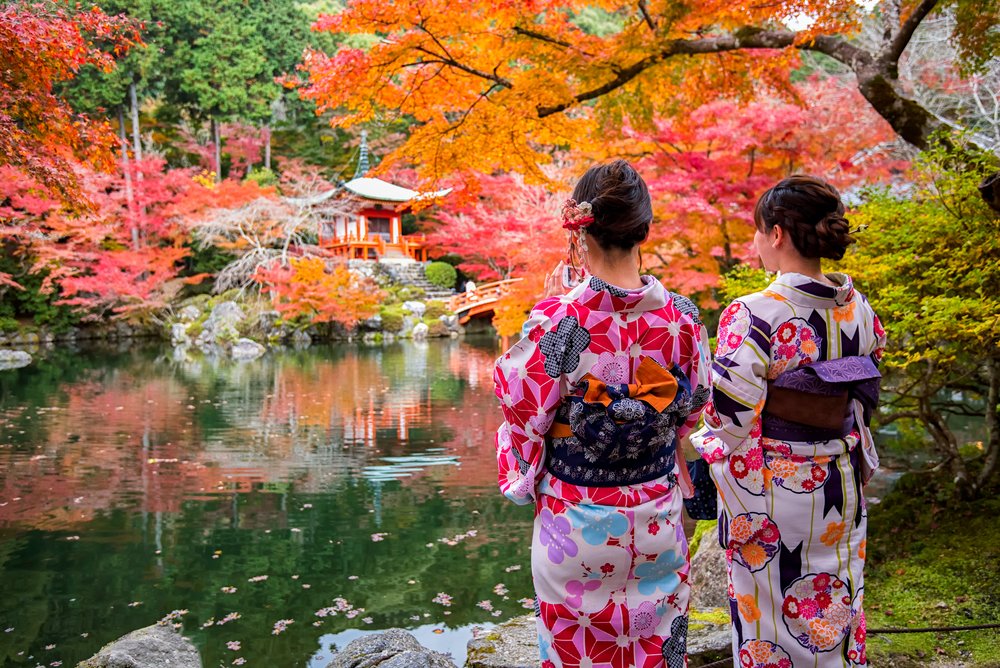
Autumn foliage creates dramatic backdrops for kimono photography in Kyoto
Autumn Photography Advantages:
- Dramatic color contrasts perfect for striking photographs
- Rich, warm lighting that enhances kimono textures
- Comfortable weather conditions for extended shoots
- Symbolic representation of seasonal change in Japanese culture
- Diverse color palettes from different tree species
Peak Autumn Foliage Timing:
- Early November: Ginkgo trees turn golden yellow
- Mid-November: Maple trees reach peak red coloration
- Late November: Mixed foliage creates complex color patterns
- Early December: Final autumn colors before winter
Top 10 Kimono-Friendly Gardens in Kyoto
1. Kyoto Botanical Garden: The Premier Kimono Photography Destination
Established in 1924, Kyoto Botanical Garden stands as Japan’s oldest public botanical garden, offering 24 hectares of meticulously maintained landscapes perfect for kimono photography. The garden’s diverse collection of flora provides year-round opportunities for stunning photographs, with each season offering unique backdrops for traditional attire.
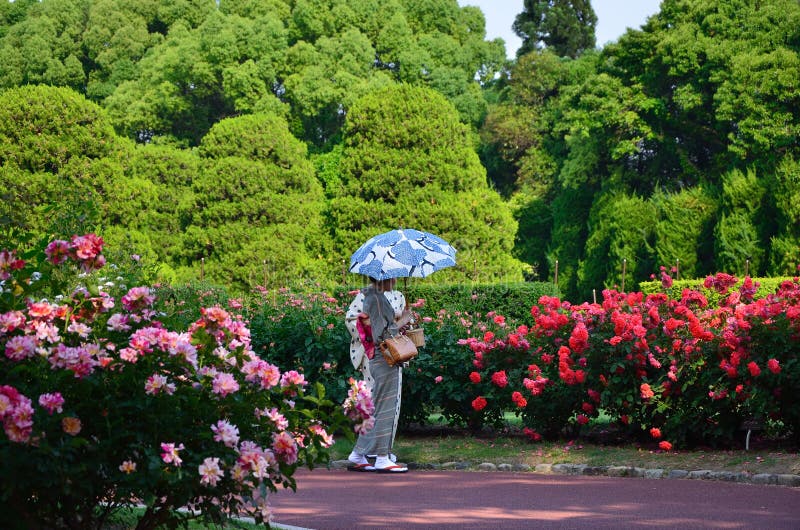
Kyoto Botanical Garden offers diverse seasonal backdrops for kimono photography
Key Features for Kimono Photography:
- Traditional Japanese garden sections with koi ponds and stone lanterns
- Cherry blossom groves with over 500 trees of different varieties
- Maple tree collections showcasing autumn’s full spectrum
- Bamboo groves creating natural green corridors
- Seasonal flower displays providing colorful backdrops
Photography Opportunities:
- Spring: Cherry blossoms create delicate pink canopies
- Summer: Lush green foliage provides cooling shade
- Autumn: Maple trees burst into fiery reds and oranges
- Winter: Bare branches create minimalist compositions
The garden’s accessibility from central Kyoto makes it an ideal choice for kimono rental and photography sessions. Professional photographers often recommend early morning visits to capture the best lighting and avoid crowds.
2. Kiyomizu-dera Temple: Elevated Garden Views
Perched on Kyoto’s eastern hills, Kiyomizu-dera offers breathtaking panoramic views of the city surrounded by seasonal foliage. The temple’s famous wooden stage provides an elevated platform for kimono photography, with the changing seasons creating dramatic backdrops throughout the year.
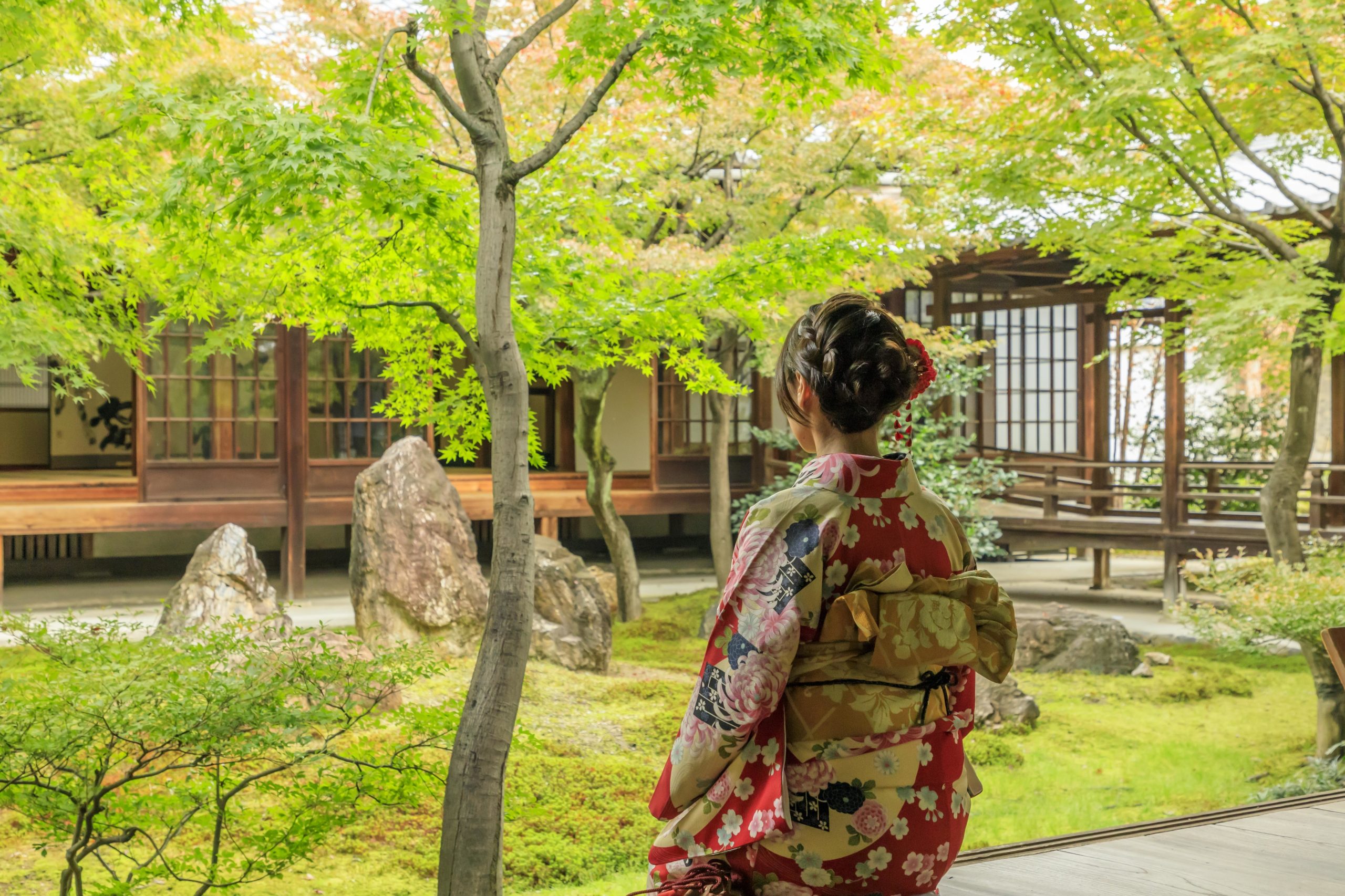
Kiyomizu-dera Temple provides elevated perspectives for dramatic kimono photography
Photography Highlights:
- Wooden terraces overlooking autumn maple forests
- Stone pathways winding through temple grounds
- Traditional architecture complementing kimono aesthetics
- Seasonal illuminations during peak foliage periods
- Historic atmosphere enhancing cultural authenticity
3. Tofuku-ji Temple: Zen Garden Serenity
Tofuku-ji Temple features one of Kyoto’s most photographed Zen gardens, with carefully raked gravel patterns and strategically placed rocks creating meditative spaces perfect for kimono photography. The temple’s maple groves transform into a sea of red during autumn, providing dramatic contrasts for traditional attire.
Tofuku-ji Temple’s zen gardens provide serene backdrops for contemplative kimono photography
Garden Photography Features:
- Geometric zen garden patterns
- Ancient maple trees over 600 years old
- Stone bridges crossing seasonal streams
- Moss-covered pathways through forest sections
- Traditional temple architecture as backdrop
4. Arashiyama Bamboo Grove: Natural Green Corridors
The famous Arashiyama Bamboo Grove creates cathedral-like corridors of towering bamboo, filtering sunlight into ethereal green patterns perfect for kimono photography. The grove’s year-round green canopy provides consistent photography opportunities, while nearby temples and gardens offer seasonal variety.
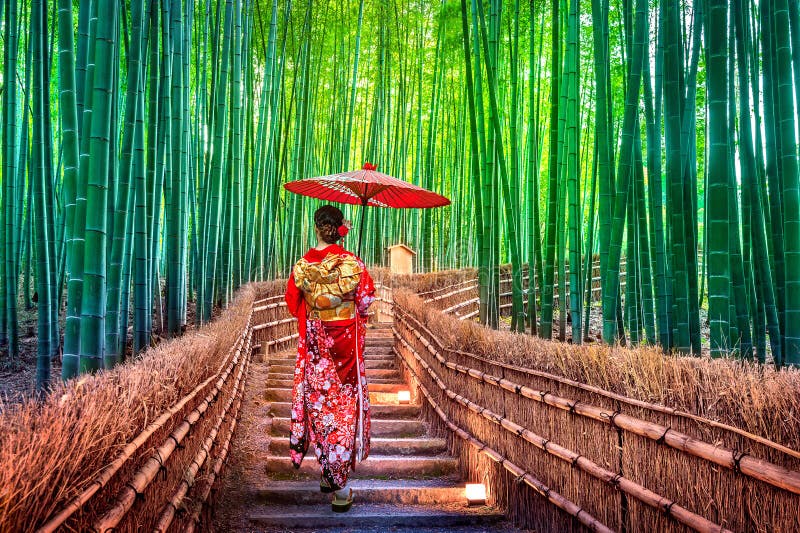
Arashiyama Bamboo Grove creates mystical green corridors for unique kimono photography
Unique Photography Opportunities:
- Filtered green light creating mystical atmospheres
- Geometric patterns formed by bamboo stalks
- Seasonal undergrowth changes throughout the year
- Traditional pathways winding through bamboo forests
- Nearby Togetsukyo Bridge providing river views
5. Eikando Temple: Reflection Garden Photography
Eikando Temple, known as the “Temple of Autumn Leaves,” features stunning pond reflections that double the visual impact of seasonal foliage. The temple’s gardens provide multiple vantage points for kimono photography, with each angle offering different perspectives on the harmony between traditional attire and natural beauty.
Reflection Photography Specialties:
- Lotus pond reflections doubling autumn colors
- Multiple viewing platforms at different elevations
- Traditional tea houses providing architectural interest
- Seasonal flower displays complementing foliage
- Stone lanterns creating focal points throughout gardens
6. Nanzen-ji Temple: Architectural Garden Integration
Nanzen-ji Temple seamlessly integrates traditional architecture with natural gardens, creating diverse backdrops for kimono photography. The temple’s famous aqueduct provides unique industrial-meets-traditional photographic opportunities, while the surrounding gardens offer seasonal beauty throughout the year.
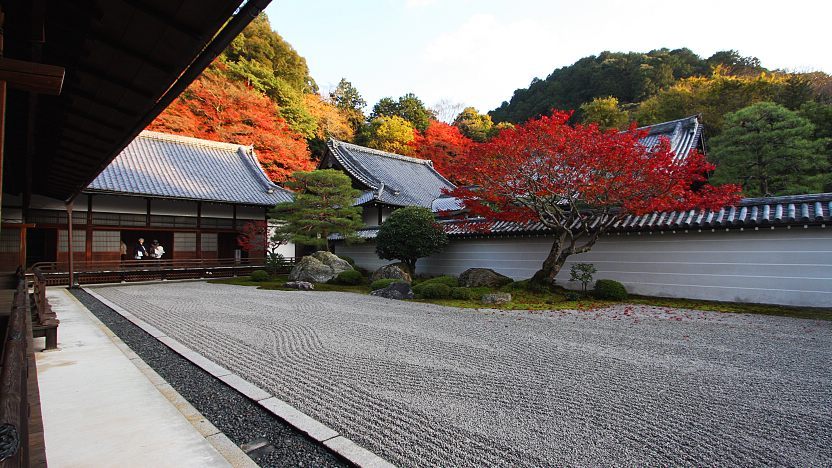
Nanzen-ji Temple combines traditional architecture with natural gardens for versatile kimono photography
Photography Versatility:
- Historic aqueduct creating unique architectural backdrops
- Traditional gate structures framing garden views
- Seasonal gardens with carefully planned color schemes
- Stone pathways leading to photogenic viewpoints
- Integration of built and natural environments
7. Ginkaku-ji (Silver Pavilion): Minimalist Garden Aesthetics
Ginkaku-ji’s carefully designed gardens exemplify Japanese minimalist aesthetics, providing elegant backdrops for kimono photography that emphasize subtle beauty over dramatic displays. The temple’s approach to garden design creates contemplative spaces perfect for capturing the serene aspects of traditional Japanese culture.
Minimalist Photography Features:
- Carefully composed garden vistas
- Subtle seasonal color changes
- Raked gravel patterns creating geometric interest
- Ancient trees providing natural focal points
- Traditional pavilion architecture as backdrop
8. Ryoan-ji Temple: Zen Rock Garden Simplicity
Ryoan-ji’s famous rock garden represents the pinnacle of Zen garden design, offering unique opportunities for kimono photography that emphasizes the contrast between ornate traditional clothing and minimalist garden philosophy. The temple’s surrounding gardens provide seasonal variety while maintaining the contemplative atmosphere.
Zen Photography Opportunities:
- Minimalist rock arrangements creating geometric patterns
- Traditional viewing platforms for contemplative poses
- Seasonal surrounding gardens providing color accents
- Historic temple buildings as architectural backdrops
- Contemplative atmosphere enhancing cultural authenticity
9. Shosei-en Garden: Hidden Gem Near Kyoto Station
Shosei-en Garden, conveniently located near Kyoto Station, offers classical Japanese garden design with excellent accessibility for kimono photography sessions. The garden’s traditional elements, including bridges, tea houses, and seasonal plantings, provide diverse photographic opportunities within a compact, easily navigable space.
Convenient Photography Features:
- Easy access from major transportation hubs
- Diverse garden elements within compact space
- Traditional bridges creating focal points
- Seasonal flower displays providing colorful backdrops
- Historic tea houses offering architectural interest
10. Maruyama Park: Cherry Blossom Central
Maruyama Park serves as Kyoto’s premier cherry blossom viewing destination, with over 680 cherry trees creating spectacular spring displays perfect for kimono photography. The park’s open spaces and diverse tree varieties provide numerous photography opportunities during peak sakura season.
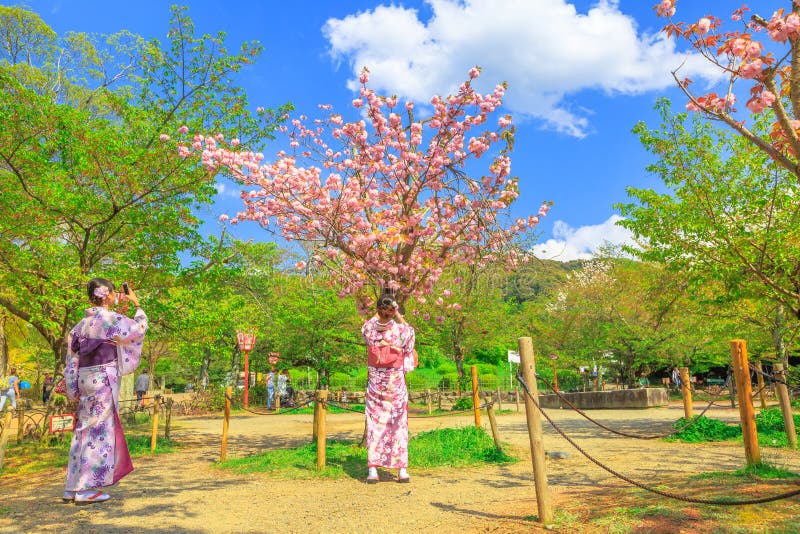
Maruyama Park offers Kyoto’s most celebrated cherry blossom viewing experience
Cherry Blossom Photography Highlights:
- Extensive cherry tree groves with multiple varieties
- Open spaces allowing for diverse composition options
- Traditional park elements complementing natural beauty
- Seasonal festivals creating cultural atmosphere
- Easy accessibility for kimono rental and photography
Kyoto Botanical Garden: A Photographer’s Paradise
Detailed Photography Guide
Kyoto Botanical Garden represents the gold standard for kimono garden photography, offering unparalleled diversity in a single location. The garden’s 24-hectare expanse provides numerous micro-environments, each offering unique photography opportunities that complement different kimono styles and seasonal preferences.
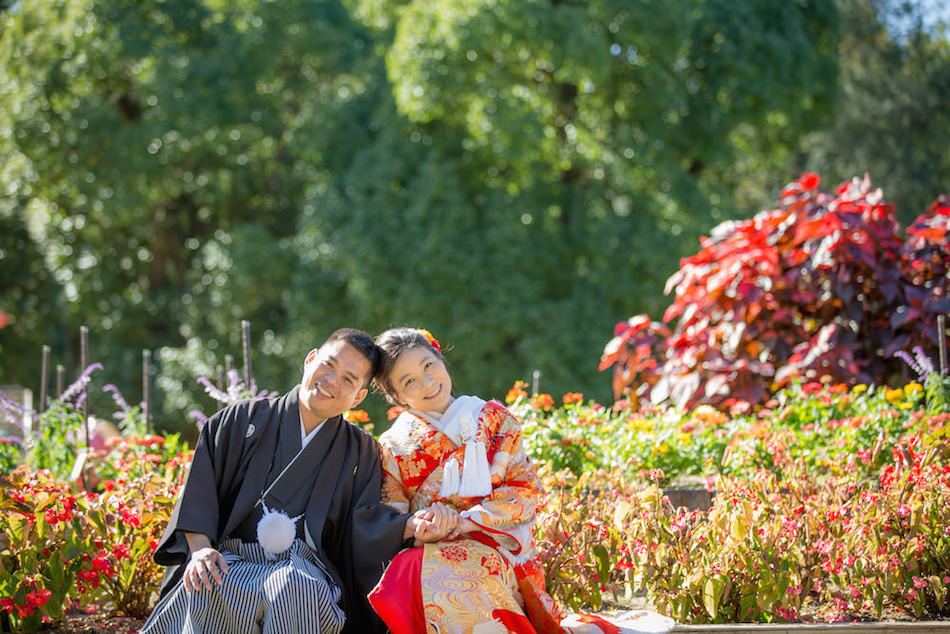
Kyoto Botanical Garden provides diverse environments for comprehensive kimono photography
Seasonal Photography Calendar:
Spring (March-May):
- Cherry blossom peak: Late March to early May
- Tulip displays: March to April
- Azalea blooms: April to May
- Fresh green foliage: April to June
Summer (June-August):
- Hydrangea displays: June to July
- Lotus pond blooms: July to August
- Lush green canopies: June to August
- Evening light photography: Extended daylight hours
Autumn (September-December):
- Maple color change: November to December
- Ginkgo golden displays: November
- Chrysanthemum exhibitions: October to November
- Mixed foliage peak: Mid to late November
Winter (December-February):
- Bare branch compositions: December to February
- Camellia blooms: December to March
- Minimalist garden aesthetics: Year-round
- Snow photography opportunities: Occasional
Professional Photography Zones
Zone 1: Japanese Traditional Garden
This section features classic Japanese garden elements including koi ponds, stone lanterns, and carefully pruned trees. The traditional design philosophy creates perfect harmony with kimono aesthetics, providing authentic cultural backdrops for photography.
Zone 2: Cherry Blossom Grove
Over 500 cherry trees of various species create spectacular spring displays. Different varieties bloom at different times, extending the photography season and providing diverse pink and white color palettes.
Zone 3: Maple Forest
Dedicated maple sections showcase autumn’s full spectrum, from golden yellows to deep crimson reds. The forest setting provides natural light filtering and intimate photography spaces.
Zone 4: Bamboo Collections
Various bamboo species create natural green corridors and geometric patterns perfect for year-round photography. The consistent green backdrop complements all kimono color schemes.
Zone 5: Seasonal Flower Displays
Rotating seasonal displays provide colorful backdrops throughout the year, from spring tulips to autumn chrysanthemums.
Historic Temple Gardens for Kimono Photography
Temple Garden Photography Ethics and Guidelines
When photographing kimono in historic temple gardens, understanding proper etiquette and cultural sensitivity enhances both the experience and resulting photographs. Temple gardens serve as spiritual spaces first, making respectful behavior essential for meaningful photography.
Photography Etiquette Guidelines:
- Obtain proper permissions before commercial photography
- Respect worship services and religious ceremonies
- Avoid blocking pathways or disturbing other visitors
- Follow specific temple rules regarding photography restrictions
- Maintain quiet, respectful demeanor throughout visits
Kiyomizu-dera Temple: Elevated Perspectives
Kiyomizu-dera’s elevated position provides unique photography opportunities showcasing both intimate garden details and expansive city views. The temple’s wooden architecture creates natural frames for kimono photography, while seasonal foliage provides ever-changing backdrops.
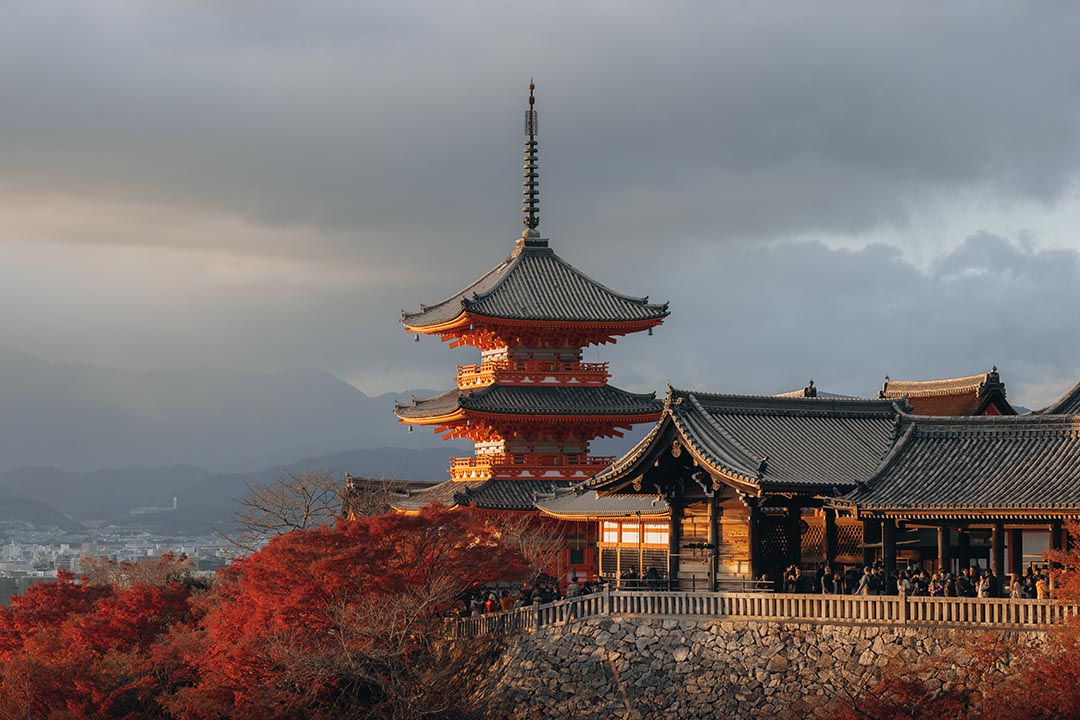
Kiyomizu-dera’s elevated wooden stage offers panoramic views for dramatic kimono photography
Seasonal Photography Opportunities:
- Spring: Cherry blossoms frame the famous wooden stage
- Summer: Lush green foliage creates cooling shade
- Autumn: Maple forests surround the temple in fiery colors
- Winter: Bare branches create minimalist compositions
Photography Timing:
- Early morning: Soft lighting and fewer crowds
- Late afternoon: Golden hour lighting enhances autumn colors
- Evening illuminations: Special seasonal lighting events
- Weekday visits: Reduced crowds for better photography conditions
Tofuku-ji Temple: Zen Garden Mastery
Tofuku-ji’s reputation as Kyoto’s premier autumn foliage destination makes it essential for kimono photography during peak season. The temple’s Zen garden design principles create contemplative spaces that enhance the meditative aspects of traditional Japanese culture.

Tofuku-ji Temple exemplifies the perfect integration of zen garden principles with seasonal beauty
Garden Photography Sections:
- Hojo Garden: Four seasonal gardens surrounding the main hall
- Kaisando Garden: Traditional pond garden with stone bridges
- Ryogin-an: Sub-temple with intimate garden spaces
- Tsuten-kyo Bridge: Elevated viewing platform over maple groves
Professional Photography Tips:
- Visit during early morning for optimal lighting
- Focus on reflection photography in pond sections
- Capture geometric patterns in raked gravel areas
- Use temple architecture as natural frames
- Emphasize the contrast between kimono colors and garden elements
Gion District: Traditional Streets Meet Natural Beauty
Gion District Photography Guide
The historic Gion district combines traditional architecture with seasonal natural beauty, creating unique urban garden photography opportunities. The district’s preserved Edo-period streetscapes provide authentic backdrops for kimono photography, while seasonal trees and traditional gardens add natural elements.

Gion district’s preserved traditional architecture provides authentic backdrops for kimono photography
Key Photography Locations in Gion:
Hanami-koji Street:
- Traditional wooden buildings creating authentic backdrops
- Seasonal hanging decorations complementing kimono colors
- Historic tea houses providing architectural interest
- Stone pathways and traditional lanterns adding cultural elements
Shirakawa Area:
- Willow trees creating natural green canopies
- Traditional bridges crossing seasonal streams
- Historic preservation creating authentic atmosphere
- Seasonal flower displays along waterways
Yasaka Shrine:
- Traditional shrine architecture providing cultural backdrops
- Seasonal cherry trees creating spring photography opportunities
- Stone lanterns and traditional elements throughout grounds
- Integration of spiritual and natural elements
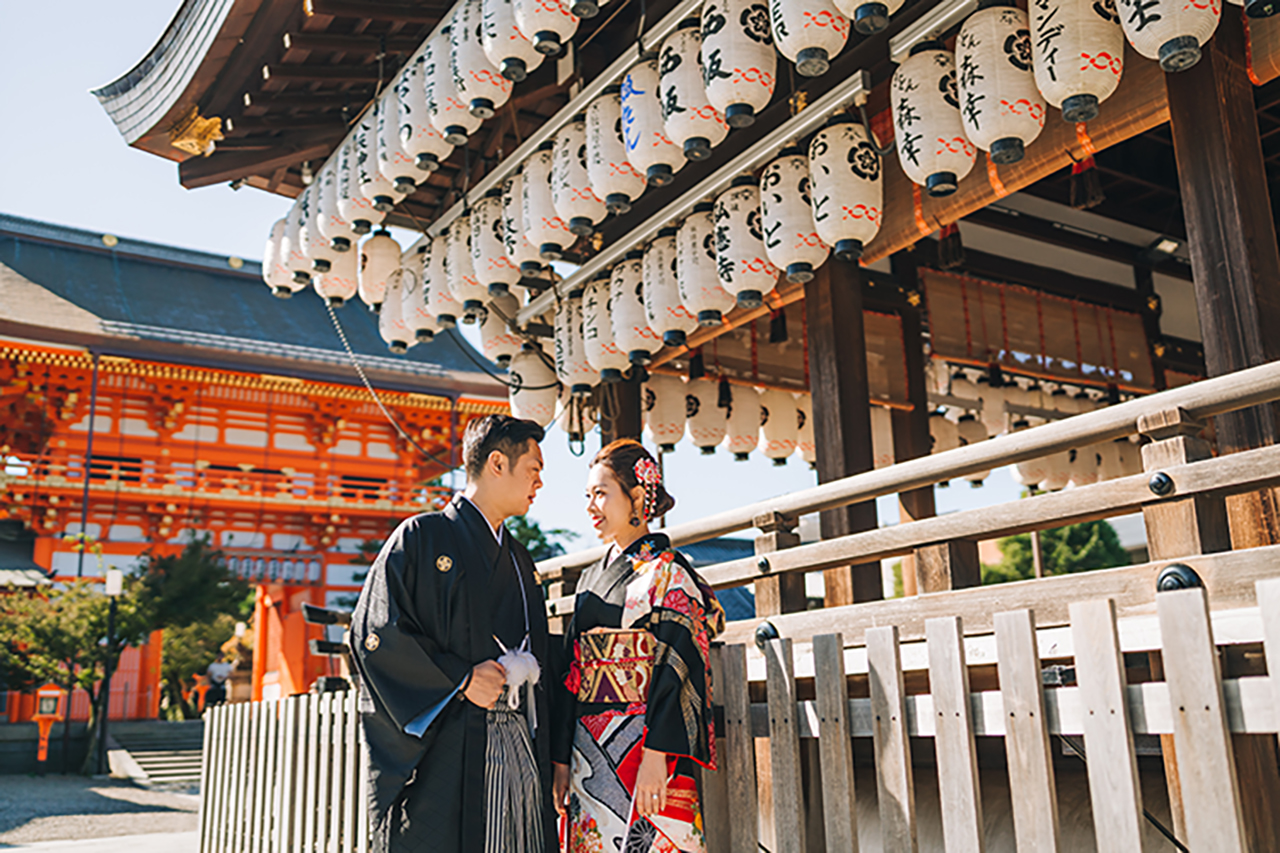
Gion district offers authentic cultural settings for professional kimono photography
Seasonal Gion Photography Strategies
Spring Photography in Gion:
- Cherry trees along Shirakawa create romantic backdrops
- Traditional lanterns complement soft spring lighting
- Seasonal festivals provide cultural atmosphere
- Fresh green foliage contrasts with traditional architecture
Autumn Photography in Gion:
- Maple trees create dramatic color contrasts
- Traditional wooden buildings complement warm autumn tones
- Seasonal decorations enhance cultural authenticity
- Golden hour lighting enhances both architectural and natural elements
Photography Timing and Logistics:
- Early morning: Avoid crowds and capture soft lighting
- Weekday visits: Reduced tourist traffic for better photography
- Seasonal festivals: Cultural events provide authentic atmosphere
- Evening illuminations: Traditional lanterns create atmospheric lighting
Kimono Rental Guide for Garden Photography
Choosing the Perfect Kimono for Garden Photography
Selecting the right kimono for garden photography involves considering seasonal colors, garden settings, and photographic goals. The harmony between kimono design and natural surroundings creates the foundation for stunning photographs that capture the essence of Japanese aesthetics.

Professional kimono rental services ensure authentic styling for garden photography
Seasonal Kimono Selection:
Spring Kimono Choices:
- Pastel colors complementing cherry blossoms
- Floral patterns echoing seasonal blooms
- Light fabrics appropriate for mild weather
- Traditional spring motifs (cherry blossoms, butterflies, flowing water)
Summer Kimono Options:
- Cooling fabrics like linen and cotton
- Lighter colors reflecting summer heat
- Floral patterns representing summer blooms
- Traditional summer motifs (fireworks, goldfish, fans)
Autumn Kimono Selections:
- Warm colors matching autumn foliage
- Rich fabrics appropriate for cooler weather
- Seasonal patterns (maple leaves, chrysanthemums, moon motifs)
- Traditional autumn color palettes
Winter Kimono Choices:
- Warming fabrics for cold weather
- Deeper colors contrasting with bare branches
- Traditional winter motifs (snow, pine trees, plum blossoms)
- Elegant patterns suitable for minimalist winter gardens
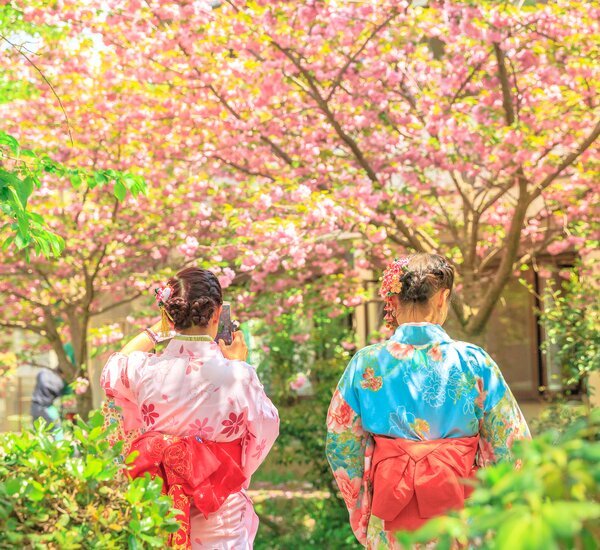
Seasonal kimono selection enhances harmony with garden environments
Professional Kimono Rental Services
Rental Service Features to Consider:
- Professional dressing assistance ensuring proper fit
- Photography-friendly kimono selection
- Seasonal color coordination advice
- Accessory packages including obi, bags, and hair ornaments
- Flexible rental periods for extended photography sessions
Rental Preparation Tips:
- Book in advance during peak seasons
- Communicate photography goals to rental staff
- Consider weather conditions when selecting fabrics
- Plan transportation to avoid kimono damage
- Arrange professional photography services in advance
For professional kimono photography services, AllPhoto Kyoto offers comprehensive packages including kimono coordination, professional photography, and garden location guidance, ensuring your kimono garden experience is captured perfectly.
Professional Photography Tips for Kimono Gardens
Technical Photography Considerations
Lighting Strategies:
- Golden hour photography for warm, flattering light
- Overcast conditions for soft, even illumination
- Backlighting to highlight kimono fabric textures
- Reflector use to fill shadows and enhance details
Composition Techniques:
- Rule of thirds placing kimono subjects strategically
- Leading lines using garden pathways and architectural elements
- Framing techniques with tree branches and architectural features
- Depth of field control to separate subjects from backgrounds
Color Harmony Principles:
- Complementary colors between kimono and garden elements
- Monochromatic schemes for sophisticated aesthetics
- Seasonal color coordination enhancing natural beauty
- Contrast management for dramatic visual impact
Capturing Cultural Authenticity
Traditional Pose Guidance:
- Historical walking postures appropriate for kimono
- Hand positioning reflecting traditional mannerisms
- Facial expressions conveying cultural grace
- Movement capture showing kimono fabric flow
Cultural Context Integration:
- Including traditional garden elements in compositions
- Showcasing seasonal cultural activities
- Capturing interactions with garden features
- Emphasizing the spiritual aspects of garden spaces
Storytelling Through Photography:
- Seasonal narratives reflecting Japanese cultural values
- Journey documentation through garden spaces
- Cultural activity integration (tea ceremony, flower viewing)
- Historical context preservation through authentic settings
Seasonal Color Coordination: Matching Kimono to Gardens
Spring Color Harmonies
Cherry Blossom Coordination:
- Soft pink kimono complementing sakura petals
- White and cream colors echoing pure blossoms
- Pastel green accents reflecting new foliage
- Silver and gold accents highlighting seasonal light
Garden Element Integration:
- Stone lantern greys coordinating with obi colors
- Pond reflections inspiring kimono pattern choices
- Fresh green foliage influencing accessory selections
- Traditional architectural elements guiding color schemes
Autumn Color Mastery
Maple Foliage Coordination:
- Deep red kimono echoing maple leaf colors
- Golden yellow selections matching ginkgo displays
- Orange accents reflecting mixed autumn palettes
- Earth tones harmonizing with seasonal transitions

Autumn color coordination creates stunning harmony between kimono and seasonal foliage
Seasonal Photography Strategies:
- Contrast photography emphasizing color differences
- Monochromatic approaches for sophisticated aesthetics
- Gradient coordination showing seasonal transitions
- Texture emphasis highlighting both fabric and foliage
Professional Color Consultation
Understanding color theory enhances kimono garden photography significantly. Professional photographers specializing in cultural photography can provide expert guidance on color coordination, ensuring your kimono selections create optimal harmony with garden settings throughout the seasons.
Planning Your Perfect Kimono Garden Experience
Comprehensive Planning Guide
Pre-Visit Planning:
- Seasonal timing research for optimal garden conditions
- Weather monitoring for photography-friendly conditions
- Garden accessibility and transportation planning
- Professional photography service booking
- Kimono rental reservation and coordination
Day-of-Experience Optimization:
- Early arrival for optimal lighting and reduced crowds
- Flexible scheduling accommodating weather changes
- Professional photographer coordination for seamless sessions
- Garden route planning maximizing photographic opportunities
- Cultural etiquette preparation for respectful garden visits
Creating Lasting Memories
The combination of traditional kimono and Kyoto’s stunning gardens creates once-in-a-lifetime experiences that deserve professional documentation. Whether capturing intimate moments or creating artistic portfolios, the investment in professional photography ensures these cultural experiences are preserved with the quality they deserve.
Professional Photography Benefits:
- Expert knowledge of optimal garden locations and timing
- Technical expertise ensuring high-quality image capture
- Cultural sensitivity ensuring respectful documentation
- Artistic vision creating compelling visual narratives
- Professional editing enhancing natural beauty
For the ultimate kimono garden photography experience, consider professional services that combine cultural expertise with artistic vision. AllPhoto Kyoto specializes in capturing the perfect harmony between traditional Japanese culture and natural beauty, creating stunning photographs that preserve these meaningful experiences for years to come.
Conclusion: Embracing the Harmony of Tradition and Nature
The art of kimono garden photography in Kyoto represents more than just beautiful pictures—it’s a celebration of Japanese cultural heritage set against the backdrop of nature’s seasonal beauty. From the delicate cherry blossoms of spring to the fiery maple leaves of autumn, each season offers unique opportunities to capture the timeless elegance of traditional Japanese aesthetics.
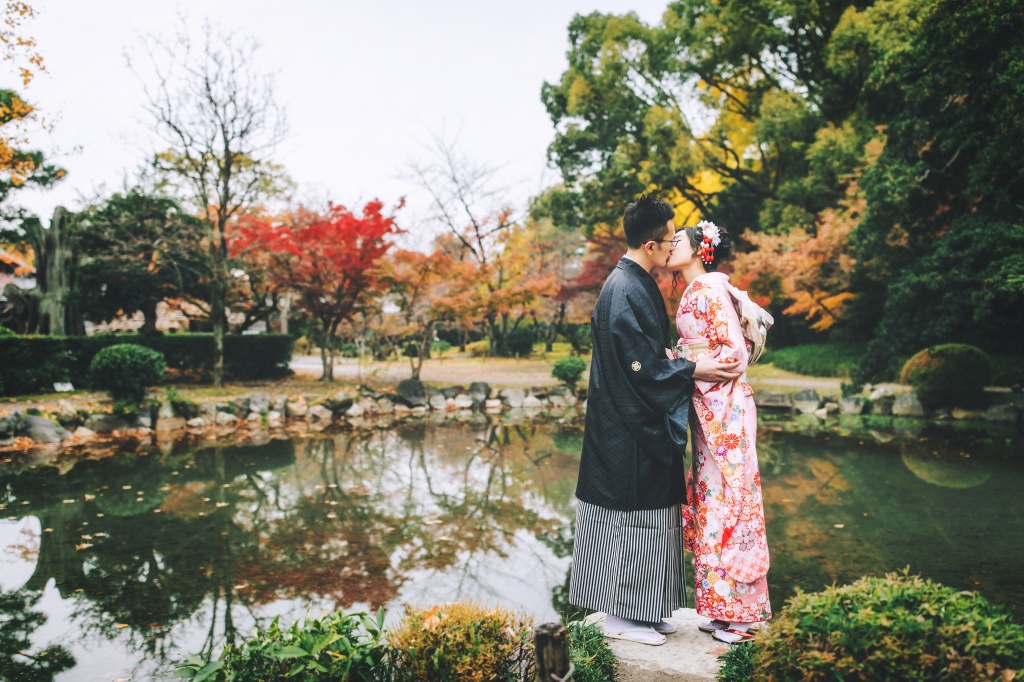
Professional kimono photography captures the eternal beauty of Japanese cultural traditions
Whether you’re a first-time visitor or a seasoned Kyoto enthusiast, the combination of carefully chosen kimono and thoughtfully selected garden locations creates photography opportunities that honor both cultural tradition and natural beauty. The gardens of Kyoto, with their centuries of careful cultivation and design, provide the perfect stages for this cultural performance.
Through professional photography services like those offered by AllPhoto Kyoto, these fleeting moments of cultural beauty can be preserved with the artistic quality they deserve. The investment in professional documentation ensures that your kimono garden experience becomes a lasting testament to the enduring beauty of Japanese culture and the natural world.
As you plan your own kimono garden photography adventure, remember that the true value lies not just in the resulting photographs, but in the cultural connection and mindful appreciation of beauty that comes from walking in the footsteps of centuries of Japanese tradition. Each step through these historic gardens, each moment captured in traditional dress, contributes to your own personal understanding of the harmony between human culture and natural beauty that defines the essence of Japan.
The enchanting gardens of Kyoto await your visit, ready to provide the perfect backdrop for your own kimono photography journey. Whether you choose the expansive beauty of Kyoto Botanical Garden, the historic elegance of temple grounds, or the authentic charm of Gion district, your kimono garden experience will create memories and photographs that celebrate the timeless beauty of Japanese culture.
Ready to capture your own kimono garden photography experience? Visit AllPhoto Kyoto to book professional photography services that will perfectly capture your journey through Kyoto’s most beautiful gardens.
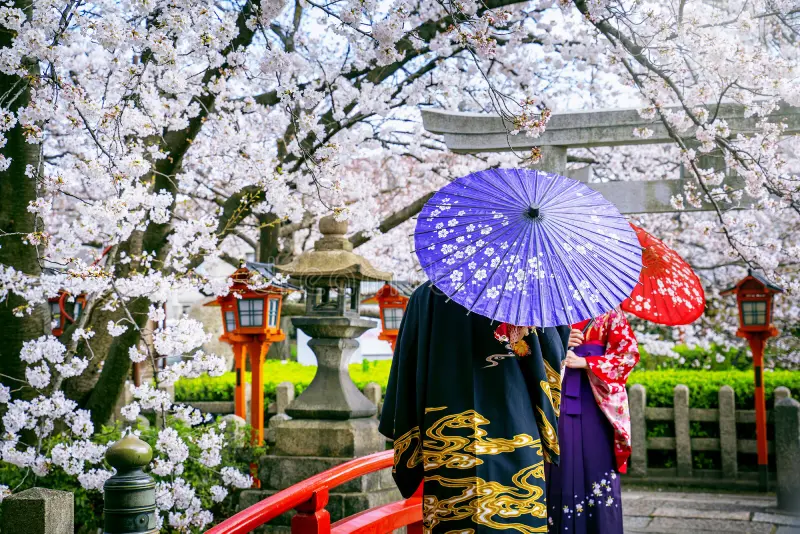


コメント